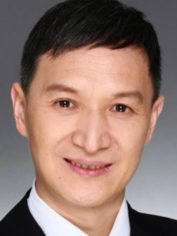Merlion RFID Forum Webinar Series: Metamaterial based near-field antennas

Dr. Xianming Qing
Department of Signal Processing, RF & Optical (SRO), Institute for Infocomm Research, Singapore
Date: 4:00pm to 5:00pm, 4 SEP 2020
Venue: Webinar
Abstract:
Near-field antennas have been applied in a number of short-range wireless systems, including near-field communication (NFC), radio-frequency identification (RFID), wireless power transfer, wireless charging, medical hyperthermia and imaging systems, antenna measurement systems, and so on. Considering the requirements of the application scenarios, the design considerations and challenges of a near-field antenna are distinct different from that of a far-field antenna. Furthermore, the characterizing parameters such as gain, radiation pattern, beamwidth, and so on, for a far-field antenna are no longer valid for a near-field antenna, instead, the electric/magnetic field distribution over a specific field of view, the filed intensity, and the Q-factor for some applications instead are of more importance. In this webinar, we will address metamaterial-based near-field antenna is the zero-phase-shift line (ZPSL) loop antenna for UHF near-field RFID application.
The UHF RFID reader antenna is required to generate strong and uniform magnetic field in a specific electrically large zone while a conventional solid-line loop is unable to achieve the goal since the current that flows on the solid-line loop encounters phase-inversion as well as magnitude-null. By contrast, the current that flows on the ZPSL is with a limited phase lag and therefore an electrically large ZPSL loop is capable to keep a uniform and in-phase flowing current, which makes it suitable to design electrically large loop antennas that produce a much enlarged interrogation zone. A numbers of electrically large ZPSL loop antennas for UHF near-field RFID readers will be are exemplified, including single-loop antenna, dual-loop antenna, grid loop array antenna, and artificial magnetic conductor backed directional loop antenna.
About the speaker: Dr. Xianming QING (M’90-SM’16-F’19) received the B. Eng from University of Electronic Science and Technology of China (UESTC), China, in 1985, and the PhD from Chiba University, Japan, in 2010.
During 1987–1996, Dr. Qing was with UESTC for teaching and research and appointed as a lecturer in 1990 and an associate professor in 1995. He joined National University of Singapore (NUS) in 1997 as a research scientist. Since 1998, he has been with the Institute for Infocomm Research (I2R, formerly known as CWC and ICR), Agency for the Agency for Science, Technology and Research (A*STAR), Singapore. He is currently holding the position of senior scientist and the leader of the RF Group. His main research interests are antenna design and characterization for wireless applications. In particular, his current R&D focuses on beam steering antennas, new material/metamaterial-based antennas, near- field antennas, medical antennas, and millimeter-wave/sub-millimeter-wave antennas & characterization.
Dr. Qing has authored/co-authored more than 270 technical papers published in international journals or presented at international conferences, and 10 book chapters. He is the editor of “handbook of Antenna Technologies” (Springer, 2016). He is holding 13 granted and filed patents. He received 6 Science and Technology Advancement Awards in P. R. China from 1987 to 1997. He is also the recipient of Singapore IES Prestigious Engineering Achievement Award 2006/2013/2014, Singapore Manufacturing Federation Award 2014, ISAP (International Symposium on Antennas and Propagation) Best Paper Award 2010, and CST University Publication Award 2015.
Dr. Qing is a fellow of IEEE. He is serving as the associate editor of IEEE Open Journal of Vehicular Technology and the International Journal of Microwave and Wireless Technologies (Cambridge University Press/EuMA), the editorial board member of Chinese Journal of Electronics (Chinese Institute of Electronics). He also served as the general co-chair of the IEEE Asia-Pacific Conference on Antennas and Propagation 2015/2018, as well as the general co-chair of 2021 IEEE International Symposium on Antennas and Propagation and USNC-URSI Radio Science Meeting.
